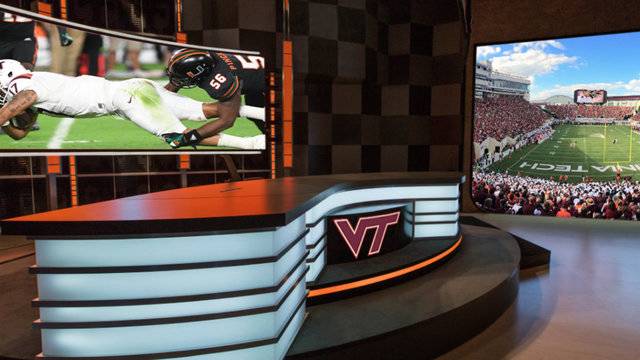The ACC television network will not officially launch until August 2019, but already the conference has announced some programming for this fall. The announcement last week pointed to as many as 30 Virginia Tech volleyball and soccer matches that will be accessible on the ACC Network Extra and the Watch ESPN app.

An artistic drawing shows what a new ACC network studio will look like when completed in the next 12 months and will be located in the south end zone area of Lane Stadium.
Eric Frey serves as the senior director of the ACC Network Operations at Virginia Tech.
“Though the network doesn’t officially launch for another year, we are operating as though it already has in every way, from scheduling to production quality to talent acquisition,” he said.
The Network will stream 30 matches from Thompson Field and Carilion Clinic Court at Cassell Coliseum.
“Our primary focus is to give Virginia Tech Athletics as much exposure as possible and to get the stories of our student-athletes in front of as many eyes as we can,” Frey said. “This partnership with ESPN leading up to and beyond the official launch one year from now allows us to do that, and the result is more coverage on this platform than ever before.”
Jon Laaser and Andrew Allegretta will be the primary play-by-play personalities for the Tech broadcasts and a rotation will be used for other play-by-play personalities and color analysts.
Jake Lawrence will be the primary analyst for volleyball matches, while Blayne Fink and Morgan Conklin will handle soccer duties.
But the best is yet to come as the network, and by the time it is officially underway, schools will have spent over $100 million of their own money to produce programming and setup onsite studios. Compare that to the Southeastern Conference (SEC) where schools only spent $30 million.
The SEC Network has been up and running for almost 18 months, and both conferences are partnering with ESPN who owns each network while profits will be spent between each conference and ESPN.
According to Pete Moris, associate athletic director at Virginia Tech, each school is expected to buy the equipment necessary to produce multiple life events for the TV channel.
“That means more linear-capable control rooms, cameras and camera angles, better replay and, in general, producing a more sophisticated broadcast than the typical digital production,” he said.
Earlier this year, the Tech Board of Visitors announced a $10 million investment that includes a control room in the South End Zone of Lane Stadium.
“We will also change Lane Stadium’s most visible entrance on Beamer Way into a high-end studio that will provide game-day content across Virginia Tech’s digital extensions and in-venue video boards, in addition to the ACC’s linear channels and other ESPN platforms,” Moris said.
The goal is to have these areas functional well in advance of next August in order to facilitate ample testing and training. Existing control rooms and equipment will also receive upgrades.
Whit Babcock, Virginia Tech’s director of athletics, said the ACC Network announcement is game-changing for the university and its athletic programs.
“This project will raise the visibility of our entire campus and the many impressive accomplishments of our students, faculty and coaches. It will also help showcase many of our programs that haven’t previously enjoyed substantial television exposure, in addition to giving fans increased access to all our teams’ games and events. From career development to recruiting, there are a myriad of benefits that this ambitious project will provide for Virginia Tech and our students,” Babcock said.
The Tech/ACC Network is also creating several new jobs and opportunity for media students. A total of five full-time staff should be devoted to the network by the first of the year.
Factoring in all production assistants, full-time students and graduate assistants, plus expected attrition and potential new hires, that number could be anywhere from 50-80.
The doubters have been critical of conferences starting their own sports network. Come next August, we will see. Early projections show each school could recoup their investment in two to three years.
Some early numbers estimate each school in the ACC could receive back $10 million to $15 million annually, making the investment well worth it.
The SEC Network has recorded over 60 million subscribers with ESPN calling it the most successful cable launch in history. In year one, the return per school was just over $7 million.

